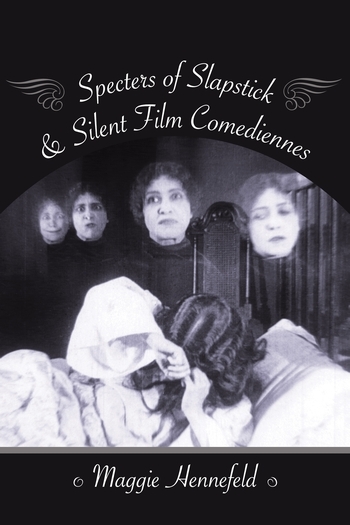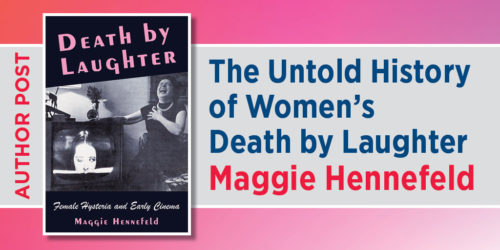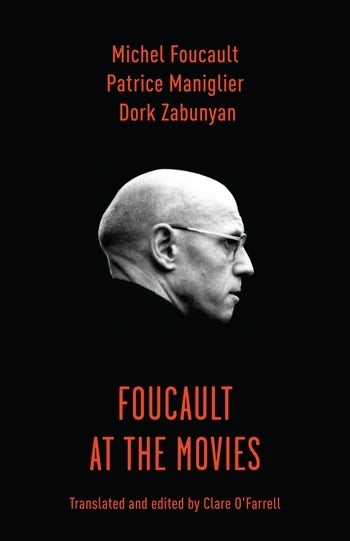Specters of Slapstick and Silent Film Comediennes on YouTube!

This week, our featured book is Specters of Slapstick and Silent Film Comediennes. Today, we are happy to present you with a compilation of author Maggie Hennefeld’s top ten films discussed in the book. Remember to enter our book giveaway by Friday at 1 PM for a chance to win a free copy!
• • • • • •
In Specters of Slapstick and Silent Film Comediennes, I write about feminist film comedies from over 100 years ago. In films with titles such as Saucy Sue, Mary Jane’s Mishap, Jane on Strike, and The Consequences of Feminism, women explode out of chimneys and melt when sprayed with soda water. Feminist activists play practical jokes to lobby for voting rights, while overworked kitchen maids dismember their limbs to finish their chores on time.
For your digital enjoyment, I’ve compiled a list of my top 10 favorite films from among the hundreds that I discuss in the book. Though many of these silent films have been lost to time, the ten selections below not only survive on celluloid, but have been digitized and are currently available on YouTube for your viewing entertainment.
Mary Jane’s Mishap (G.A. Smith, UK, 1903)
In this short trick film from 1903, a housemaid spontaneously combusts out of the chimney after pouring too much paraffin wax onto the fire. I interpret it as an absurd take on the problem of women’s confinement to the domestic sphere and their relegation to menial housework. Sometimes the only way out of the home and into the polis is through the chimney! Unlike her predecessor Bridget McKeen (featured in How Bridget Made the Fire and The Finish of Bridget McKeen), Mary Jane keeps going: her limbs and torso rain down over the village skyline in dismembered bodily pieces. She then returns as an ectoplasmic specter at her own gravestone, which has the memorable epitaph: “Here Lies Mary Jane—Rest in Pieces.” The film stars Laura Bayley, the filmmaker G.A. Smith’s wife, who also appears in short comedies such as The X-Ray Fiend (1897), A Kiss in the Tunnel (1899), and The Old Maid’s Valentine (1900).
Daisy Doodad’s Dial (Florence Turner and Laurence Trimble, UK, 1914)
Daisy Doodad is a bored housewife who trains day and night to compete in an amateur face-making competition, but is arrested for public indecency after making insane grimaces at strange men on the street car. In the film’s haunting final scene (which is the source for the book’s cover image), Daisy shuts herself up in her bedroom (like a female hysteric). There, she has extremely vivid nightmares in which she is visited by a horde of spectral superimpositions of her own comic-horrific face-making. Disembodied heads float over her supine body. The lead actress and co-director is none other than Florence Turner, who was one of the very first movie stars in the US, also know at “the Vitagraph Girl.” Turner has almost 200 screen credits to her name.
Princess Nicotine; or, The Smoke Fairy (J. Stuart Blackton, US, 1909)
This surrealist trick film depicts the plight of a gentleman smoker, who hallucinates that he is visited by two miniature, doll-sized nicotine fairies. The fairies play pranks on him, hide out in his cigar box, and moon him. In revenge, the man sadistically blows smoke in their faces, traps them in a glass jar, and tries to burn them—though they prove impervious to fire. Finally, he melts their bodies by dousing them with soda water, accidentally spraying himself in the face in the process. A virtuosic trick film in its techniques, J. Stuart Blackton (the co-director of the Vitagraph Company) and cameraman Tony Gaudio filmed these intense juxtapositions in bodily scale through the use of trick mirrors, enormous props, and hidden wires. It is a baffling and enthralling sight to behold.
Laughing Gas (Edwin S. Porter, US, 1907)
An African-American woman, Mandy (Bertha Regustus), is given nitrous-oxide (i.e. laughing gas) by her white dentist, and proceeds to spread her laughter contagiously throughout the public sphere. First to the dentist and his assistant, then to street car riders and day laborers, and finally to several police officers, everyone succumbs to Mandy’s joyful hysteria. Her contagious affect offers her a get out of jail free card when she is arrested and hauled into the station. The film concludes in an all-Black gospel church service, where Mandy’s uproarious laughter is racially segregated from these integrated public spaces. Both actively rebellious and apparently racist, Laughing Gas is must-see cinema for us all in the era of #laughingwhileblack, Nasty Women, Black Lives Matter, and Desiree Fairooz.
Madame’s Cravings [Madame A Des Envies] (Alice Guy-Blaché, France, 1906)
A pregnant woman exhibits her maternity cravings in public. Her objects of oral desire include a child’s lollipop, a wino’s glass of absinthe, a crippled beggar’s pickled herring, and the smoking pipe of a traveling salesman. Meanwhile, Madame’s husband lags behind her doing damage control and toting their other child around in a large pram. Finally, Madame’s little bundle is born in a trick cut, harvested from a cabbage patch—which is a throwback to one of the filmmaker’s earliest pictures from 1896, The Cabbage Fairy. Alice Guy-Blaché directed over 500 films between 1896 and 1920.
A Florida Enchantment (Sidney Drew, US, 1914)
A bored housewife dreams that she inherits magical seeds from Africa that spontaneously transform her into a man. She then forces her African-American housemaid to ingest the seeds, which reduce the poor woman to a racist, chest-thumping caricature out of a Jim Crow minstrelsy revue. The metamorphosis is even rougher for her husband, who is nearly lynched by an angry, transphobic mob. While sexual reassignment is depicted as erotic for white women, and libidinally explosive for women of color, it is clearly off-limits for the men in this film—despite the longstanding theatrical and burlesque traditions of male-to-female cross-dressing. It is challenging to navigate the identity politics of this film’s physical comedy. Laughter erupts as an intersectional minefield, too easily slipping between racist sight gags and fantasies of gender liberation.
Magic Mirror [La Miroir Magique] (Segundo de Chomón, France, 1907)
A female magician sprays magical serum on her vanity mirror and conjures miniature dancing clones of her own body. The buttons of her cameo jewelry spring to life and her everyday objects transform into animated figures. The female magician is played by Julienne Mathieu, Segundo de Chomón’s wife, who appears in the lead role as a magician or conjuror in many of his trick films (unlike Georges Méliès or Gaston Velle, who represented women ornamentally while themselves playing the prestidigitator). Many of Mathieu’s performances are easily viewable on YouTube, including Electric Hotel, The Frog, and The Red Spectre. Though not exactly laugh out loud funny, these uncanny films provoke a curious affect that draws on clownish gestures and often borders on dark humor.
A Sticky Woman [Une Femme Collante] (Alice Guy-Blaché, France, 1906)
Another classic from the prolific female filmmaker and screen comedienne, Alice Guy-Blaché, A Sticky Woman is a trans-feminist film about sexual predation in public space. The premise is simple: a housemaid licks stamps in the postage office at the behest of her female employer. When her repetitively flapping tongue arouses the interest of a lascivious male onlooker, he exploits the situation and attempts to molest her by stealing a kiss. Unfortunately for him, the residual glue from her lips causes their faces to stick together. After a boy postal clerk snips them apart with scissors, half of the masher’s mustache is transferred to the sticky woman’s face in a gender fluid sight gag!
Mabel’s Strange Predicament (Mabel Normand, US, 1914)
If you’ve never heard of Mabel Normand, you’re in for a treat. She was an extremely prolific and widely famous slapstick comedienne and filmmaker, who paved the way for women in comedy from Lucille Ball, Moms Mabley and Phyllis Diller, to Ali Wong, Wanda Sykes, and Amy Schumer. Normand often appeared across from Charlie Chaplin in Keystone film comedies, but Mabel’s Strange Predicament has the distinction of being Chaplin’s debut screen appearance as his iconic tramp character (for which Normand gets directorial credit). In this film, Mabel and Charlie have misadventures in a hotel. He is a drunk who tries and fails to seduce her. On top of this social predicament of sexual predation, Mabel’s dog accidentally locks her out of her own hotel room while she is in her pajamas. The older couple next door gets involved and things unravel from there.
Those Awful Hats (D.W. Griffith, US, 1909)
There is nothing worse than attending a film where you are seated behind a woman wearing an enormous hat! This large hat problem bedeviled film exhibitors and male spectators alike throughout the early 1900s and 1910s. From the Merry Widow Hat, to the Russian Shako, to the Georgian Peach Basket, women’s hat fashions butted heads with the sheer visibility of the film screen. In this short promo comedy, directed by the notorious D.W. Griffith of all people, Flora Finch learns the hard way about the perils of hat-wearing in a movie theater, when a theater manager installs a large ceiling crane that forcibly removes women’s hats—sometimes along with their bodies, as pictured here.







